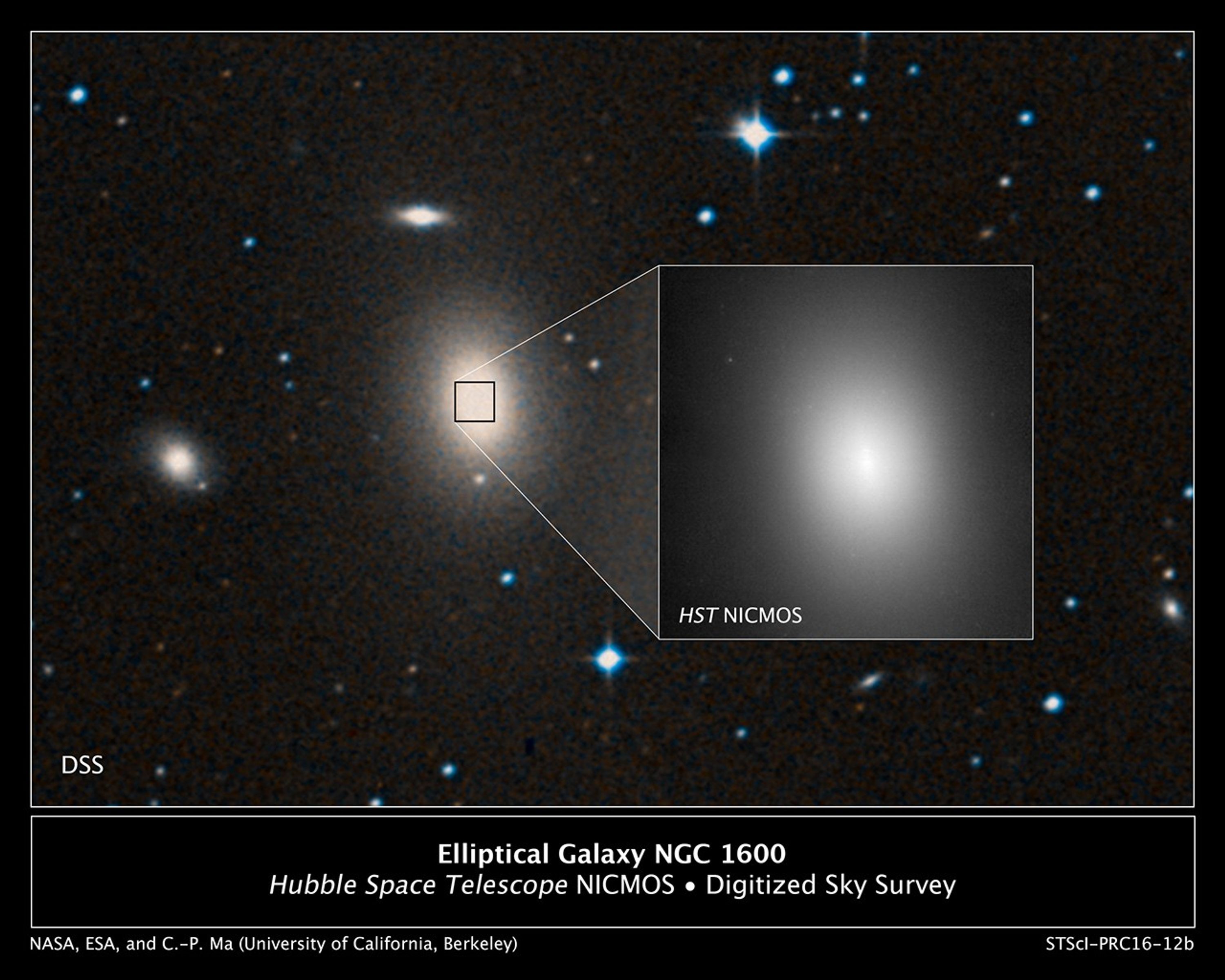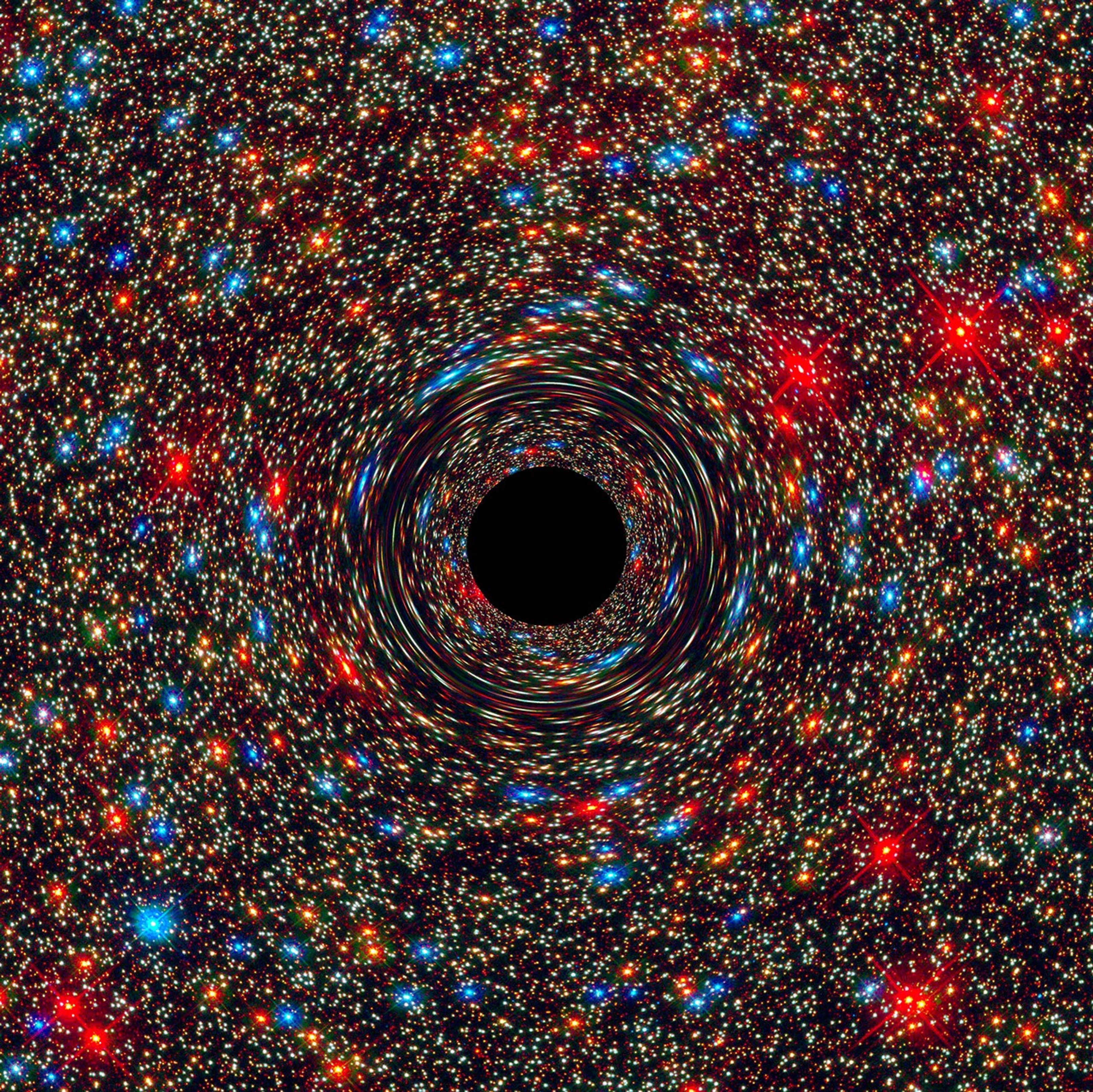1 min read
A View of the Giant Elliptical Galaxy NGC 1600

The massive elliptical galaxy in the center of this image, taken by the Digitized Sky Survey, resides in an uncluttered region of space. A close-up view of the galaxy, called NGC 1600, is shown in the inset image, which was taken in near-infrared light by the Hubble Space Telescope's Near Infrared Camera and Multi-Object Spectrometer (NICMOS).
At the heart of NGC 1600 lurks one of the most massive black holes ever detected. The supersized black hole, weighing 17 billion suns, resides in an unlikely place. The biggest supermassive black holes – those roughly 10 billion times the mass of our sun – have been found at the cores of very large galaxies in regions of the universe packed with other large galaxies. This black hole, however, lives in a cosmic backwater town.
Astronomers suggest that the black hole grew from repeated collisions between its home galaxy and neighboring galaxies, which funneled gas to the massive object. The black hole also may have merged with a black hole from one of the consumed galaxies. The frequent feasts may also explain why NGC 1600 has few neighbors.
NGC 1600 is located 209 million light-years from Earth. The NICMOS image was taken on Nov. 10, 1998.
About the Object
- R.A. PositionR.A. PositionRight ascension – analogous to longitude – is one component of an object's position.04h 31m 39.93s
- Dec. PositionDec. PositionDeclination – analogous to latitude – is one component of an object's position.-5° 5' 10.5"
- ConstellationConstellationOne of 88 recognized regions of the celestial sphere in which the object appears.Eridanus
- DistanceDistanceThe physical distance from Earth to the astronomical object. Distances within our solar system are usually measured in Astronomical Units (AU). Distances between stars are usually measured in light-years. Interstellar distances can also be measured in parsecs.209 million light-years (64 million parsecs)
About the Data
- Data DescriptionData DescriptionProposal: A description of the observations, their scientific justification, and the links to the data available in the science archive.
Science Team: The astronomers who planned the observations and analyzed the data. "PI" refers to the Principal Investigator.The HST data (inset image) were taken from proposal 7886 PI: A. Quillen (University of Rochester), G. Bower (CSC/STScI), and G. Rieke (Steward Observatory/University of Arizona). The science team comprises J. Thomas (Max Planck Institute for Extraterrestrial Physics, Garching, Germany), C.-P. Ma (University of California, Berkeley), N. McConnell (Dominion Astrophysical Observatory), J. Greene (Princeton University), J. Blakeslee (Dominion Astrophysical Observatory), and R. Janish (University of California, Berkeley). - InstrumentInstrumentThe science instrument used to produce the data.HST>NICMOS
- Exposure DatesExposure DatesThe date(s) that the telescope made its observations and the total exposure time.November 10, 1998, Exposure Time: 32 minutes
- FiltersFiltersThe camera filters that were used in the science observations.F160W
- Object NameObject NameA name or catalog number that astronomers use to identify an astronomical object.NGC 1600
- Object DescriptionObject DescriptionThe type of astronomical object.Elliptical Galaxy (inset image)
- Release DateApril 6, 2016
- Science ReleaseBehemoth Black Hole Found in an Unlikely Place
- Credit

Related Images & Videos

Black Hole in NGC 1600
This computer-simulated image shows a supermassive black hole at the core of a galaxy. The black region in the center represents the black hole's event horizon, where no light can escape the massive object's gravitational grip. The black hole's powerful gravity distorts space...
Share
Details
Claire Andreoli
NASA’s Goddard Space Flight Center
Greenbelt, Maryland
claire.andreoli@nasa.gov































